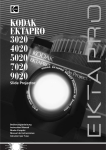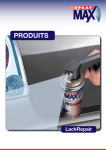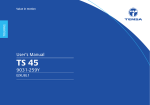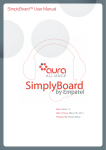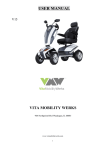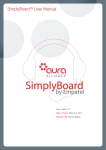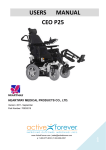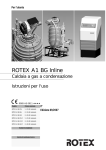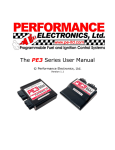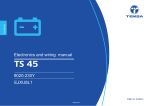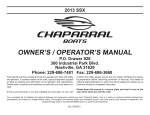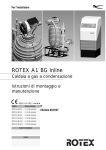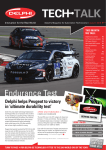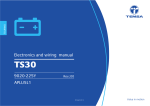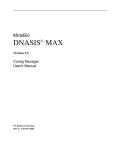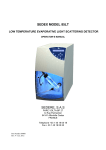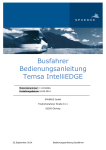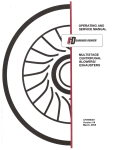Download TS 45 User Manual – Part 2
Transcript
05 HEADLAMPS AND LAMPS 5.1 5.2 5.3 5.4 Rev. 00 / 10.02.14 Internal Lamps External Lamps Illumination Lamps Headlamps TS 45|101 5.1 Internal Lamps Driver’s Reading Lamp Passengers’ Reading and Night Lamps 05 HEADLAMPS AND LAMPS Corridor Lamps Step Lamps Step lamps are located on front steps. They light up automatically when the door is opened and light off when the door is closed. Corridor lamps are controlled by “INTERIOR LIGHT” switch located on the right control panel. 102|TS 45 Driver’s Reading lamps are controlled by “DRIVER’S READING LAMP” button located on the right control panel. Passengers’ Reading and Night Lamps are controlled by the “READING LIGHT” switch located on the right control panel. INFORMATION Step lamps provide visibility when getting on and off the vehicle. Rev. 00 / 10.02.14 5.1 Internal Lamps Entrance Illumination Lamp 5.2 External Lamps Aisle Illumination Lamp Parking Lamps 05 HEADLAMPS AND LAMPS Parking lamps illuminate the exterior of the vehicle and make it visible to other drivers while parked. Entrance Illumination Lamp is located above the door. It lights up when the door is opened and turns off when the door is closed. Aisle Illumination Lamps are controlled by “AISLE LIGHTS” button located on right control panel. Press “PARKING LAMPS” button located on left control panel turn on parking lamps. INFORMATION Consult authorized TEMSA Service in case of parking lamp malfunction. Rev. 00 / 10.02.14 WARNING Never cover parking lamps with paint or label etc. TS 45|103 05 HEADLAMPS AND LAMPS 5.2 External Lamps Brake Lamps Turn Signals Brake lamps light up as long as the brake pedal is pressed. Indicates to other drivers that the driver intends a lateral change of position. They are located: 2 on front and 2 at rear, 2 on each side. Your vehicle is equipped with seven brake lamps, four are located at rear lamp group and three are at the centre of the vehicle. INFORMATION Brake lamps also light up when the retarder brake system is activated and switched off when it is deactivated. INFORMATION • Indicators are controlled by left control lever located on the steering wheel control group. • Consult authorizedTEMSA Service in case of turn signal malfunction. WARNING Check that all brake lamps function properly before driving. Consult with authorized TEMSA service in case of malfunction. 104|TS 45 Rev. 00 / 10.02.14 5.3 Illumination Lamps Rear Direction Indicator Lamp Engine Inspection Lamps Enables visibility of the vehicle for other drivers or pedestrians while driving in reversed direction. Use light switch located on engine control panel to open engine inspection lamps. WARNING Turn off light switch after use. 05 HEADLAMPS AND LAMPS 5.2 External Lamps INFORMATION Rev. 00 / 10.02.14 EM LIGHT SWITCH ERGEN CY • C onsult authorized TEMSA Service in case of rear direction indicator lamp malfunction. • When the reverse gear is shifted, hazard warning flashers start flashing and buzzer sounds. STOP ENGINE START IGNITION SWITCH TS 45|105 5.4 Headlamps 05 HEADLAMPS AND LAMPS 5.3 Illumination Lamps Luggage Compartment Lamps License Plate Lamps Low Beam Headlamps Luggage Compartment Lamps turn on when the luggage compartment lids are opened. They turn off when the lids are closed. License plate lamps, light up when parking lamps are activated. They turn off when parking lamps are deactivated. Low Beam Headlamps provide medium visibility during driving. INFORMATION Ignition key must be on position “2” to light up luggage compartment lamps. License plate lamps enable visibility of rear plate when driving in darkness. INFORMATION Consult authorized TEMSA Service in case of license plate lamp malfunction. INFORMATION • Position the “PARKING LAMP AND LOW BEAM SWITCH” located on the left control panel to the second level to turn on the low beam headlights. • Consult authorized TEMSA Service in case of low beam headlights malfunction. 106|TS 45 Rev. 00 / 10.02.14 High Beam Headlamps Front Fog Lamps Provide long range visibility during travel. See also page 52 to activate high beam headlamps. Enables higher visibility of the front part of the vehicle in wintry conditions. Press “FRONT FOG LAMP” button located on left control panel to turn the fog lamps on. 05 HEADLAMPS AND LAMPS 5.4 Headlamps INFORMATION High beams are used when the low beams are insufficient to provide high visibility. WARNING High beams will adversely affect the visibility of the driver on the opposite side. Never use the high beams if not necessary. Rev. 00 / 10.02.14 INFORMATION VISUAL INSPECTION • Turn the fog lamps on only when required by weather conditions. Unnecessary use of fog lamps may cause accidents. • Abide to country laws. Warning lamp located on warning panel lights up as long as the high beam headlamps are on. TS 45|107 108|TS 45 Rev. 00 / 10.02.14 06 DOORS AND LIDS 6.1 6.2 Rev. 00 / 10.02.14 Front Door Lids TS 45|109 06 DOORS AND LIDS 6.1 Front Door The locking mechanism is dedicated to open or close the doors from outside when engine is in ON or OFF position. Push the cap to the right to open. Insert the key to the socket, turn clockwise and then turn the locking lever clockwise. WARNING Never use door opening switches if the door is locked. This could result in damage to the locking mechanism. Press On/Off switch to open the door. Press switch to close the door from outside. 1. On/Off Switch 2. Locking Lever 3. Lock Protection Cap INFORMATION Lock protection cap prevents dust, oil, etc. from contaminating the lock mechanism. Always keep the cap closed after use. To lock the mechanism from outside, at first, rotate the lever anticlockwise and release. Then insert the key in its socket and turn anticlockwise. 110|TS 45 1 2 3 Rev. 00 / 10.02.14 1 5 6 2 2 7 1.Emergency Situation Equipment Lid 2.Left Luggage Lids 3.AdBlue and DPF Maintenance Lid 4.Radiator Maintenance Lid Rev. 00 / 10.02.14 2 3 8 8 06 DOORS AND LIDS 6.2 Lids 4 8 5.Lavatory Tank Maintenance Lid 6.Wheelchaired Passenger Lift Lid 7.Battery Maintenance Lid 8.Right Luggage Lids TS 45|111 6.2 Lids Emergency Situation Equipment Lid 06 DOORS AND LIDS The locking mechanism is dedicated to locking or unlocking the lid. Battery Maintenance Lid Push the lid downwards and turn the key clockwise to lock the mechanism. Insert the key in its lock and turn anti-clockwise. Pull the handle as shown in the figure and lift the lid. Push the lid downwards and turn the key clockwise to lock the mechanism. Insert the key in its lock and turn anti-clockwise. Pull the handle as shown in the figure and lift the lid. WARNING • Always hold the handle while opening and closing the lid. Never hold edges and inner parts of the lid. Your hand may get caught. • Do not use this area for storage. 112|TS 45 The locking mechanism is dedicated to locking or unlocking the lid. WARNING • Always hold the handle while opening and closing the lid. Never hold edges and inner parts of the lid. Your hand may get caught. • Do not use this area for storage. Rev. 00 / 10.02.14 6.2 Lids The locking mechanism is dedicated to locking or unlocking the lid. Lavatory Tank Maintenance Lid Push the lid downwards and turn the key clockwise to lock the mechanism. Insert the key in its lock and turn anti-clockwise. Pull the handle as shown in the figure and lift the lid. Push the lid downwards and turn the key clockwise to lock the mechanism. Insert the key in its lock and turn anti-clockwise. Pull the handle as shown in the figure and lift the lid. WARNING Always hold the handle while opening and closing the lid. Never hold edges and inner parts of the lid. Your hand may get caught. Rev. 00 / 10.02.14 The locking mechanism is dedicated to locking or unlocking the lid. WARNING • Always hold the handle while opening and closing the lid. Never hold edges and inner parts of the lid. Your hand may get caught. • Do not use this area for storage. TS 45|113 06 DOORS AND LIDS Left Luggage Lids 06 DOORS AND LIDS 6.2 Lids Radiator Maintenance Lid Engine Maintenance Right Lid The locking mechanism is dedicated to locking or unlocking the lid. To open the lid pull it up until it stops, press the latch to release the locking mechanism and continue to pull upwards movement. The locking mechanism is dedicated to locking or unlocking the lid. To open the lid pull it up until it stops, press the latch to release the locking mechanism and continue to pull upwards movement. HOT SURFACES When opening the engine maintenance lid beware of hot surfaces. WARNING Never hold edges or inner parts of the lid while closing. Your hands may get caught. 114|TS 45 HOT SURFACES When opening the engine maintenance lid beware of hot surfaces. WARNING Never hold edges or inner parts of the lid while closing. Your hands may get caught. Rev. 00 / 10.02.14 6.2 Lids AdBlue Outer Lid Rev. 00 / 10.02.14 WARNING 06 DOORS AND LIDS The locking mechanism is dedicated to locking or unlocking the lid. To open the lid turn the key anti-clockwise and pull upwards, to close push and turn the key clockwise. • Always hold the handle while opening and closing the lid. Never hold edges and inner parts of the lid. Your hand may get caught. • Do not use this area for storage. TS 45|115 6.2 Lids Fuel Tank Maintenance Lid Right Luggage Lids 06 DOORS AND LIDS The locking mechanism is dedicated to locking or unlocking the lid. Push the lid downwards and turn the key clockwise to lock the mechanism. Push the lid downwards and turn the key clockwise to lock the mechanism. Insert the key in its lock and turn anti-clockwise. Pull the handle as shown in the figure and lift the lid. Insert the key in its lock and turn anti-clockwise. Pull the handle as shown in the figure and lift the lid. WARNING Always hold the handle while opening and closing the lid. Never hold edges and inner parts of the lid. Your hand may get caught. 116|TS 45 The locking mechanism is dedicated to locking or unlocking the lid. WARNING • Always hold the handle while opening and closing the lid. Never hold edges and inner parts of the lid. Your hand may get caught. • Do not use this area for storage. Rev. 00 / 10.02.14 Fuel Tank Outer Lid Fuel Tank Cap The locking mechanism is dedicated to locking or unlocking the lid. To open the lid turn the key anti-clockwise and pull upwards, to close push and turn the key clockwise. Push the handle to the right to open fuel tank cap. 06 DOORS AND LIDS INFORMATION Fuel tank outer lid is located at outer part of the fuel tank maintenance lid. WARNING Spring mechanism is provided on the cap. When the handle is pushed, cap is released automatically. Rev. 00 / 10.02.14 TS 45|117 6.2 Lids Engine Maintenance Lid 06 DOORS AND LIDS The locking mechanism is dedicated to locking or unlocking the lid. To open the lid turn the key clockwise and pull the handle to open, to close push and turn the key anticlockwise. WARNING HOT SURFACES When opening the engine maintenance lid beware of hot surfaces. 118|TS 45 • Always hold the handle while opening and closing the lid. Never hold edges and inner parts of the lid. Your hand may get caught. • Do not use this area for storage. Rev. 00 / 10.02.14 06 DOORS AND LIDS Rev. 00 / 10.02.14 TS 45|119 120|TS 45 Rev. 00 / 10.02.14 07 ENGINE 7.1 7.2 7.3 7.4 7.5 7.6 7.7 7.8 7.9 Rev. 00 / 10.02.14 General Information Expansion Tank Drive Belts Engine Oil Dipstick Air Filter Steering Wheel Hydraulic Oil Tank Engine Control Panel DPF Regeneration Engine Compartment Automatic Extinguisher System TS 45|121 7.1 General Information Safety Switch 7.2 Expansion Tank Your vehicle is equipped with diesel technology which is designed to provide a safe, economical and efficient driving experience. Prevents the start up of the engine and avoids possible accidents when the maintenance lid is opened. High temperature formed during the operation of the engine is decreased by engine coolant. 07 ENGINE Safety Warnings Check that general safety rules, all warning signs and information are taken into consideration before performing any work in the engine compartment. WARNING Occupational knowledge and experience is required for replacing drive belts and adjusting belt tension. Information given in this section is intended for people with technical knowledge and competence at required level. Please consult authorized TEMSA Service for all matters regarding drive belts and engine compartment. 122|TS 45 WARNING • N ever allow unauthorized people to drive the vehicle. Remove the ignition key before operating on the engine compartment. • Always stop the engine and wait until it’s cold before performing any work in the engine compartment. • Performing work when the engine is hot may cause burning or injury. Open the engine maintenance lid to access the expansion tank. High temperature formed in engine compartment decreases whereas the engine coolant temperature increases. Engine coolant expands due to temperature differences. Expanding coolant will form steam inside the system. Over-pressurized steam is released automatically through expansion safety exits located on the top of the tank. Rev. 00 / 10.02.14 Engine Coolant INFORMATION Includes distilled water, antifreeze and corrosion inhibitor. Distilled water and anti-freeze mixing ratio varies according to weather conditions. Less antifreeze is needed in warm conditions than for cold conditions, use table as reference. The water used as coolant must be soft and well filtered. Check the coolant level when the engine is cold. Coolant level must not be below “MINIMUM” sign on the tank. WARNING Engine coolant must be replaced periodically only by authorized TEMSA Service. WARNING Coolant level increases as its temperature rises. Over-filled tank may overflow. Freeze Protection Temperatures for Antifreeze Concentrations (1) Protection to: Concentration -15˚C (5˚F) 30% glycol, 70% water -24˚C (-12˚F) 40% glycol, 60% water -37˚C (-34˚F) 50% glycol, 50% water -52˚C (-62˚F) 60% glycol, 40% water (1) Rev. 00 / 10.02.14 INFORMATION • U sing antifreeze is crucial for the performance of the vehicle. • Using antifreeze in summer would reduce corrosion and sedimentation inside the engine. • Never fill up the tank only with antifreeze. • In addition to this, antifreeze protects the engine against overheating as it increases the boiling point of water. Ethylene glycol-based antifreeze WARNING • A ddition or replacement processes of engine coolant must only be performed by authorized TEMSA Service. • Contact with engine coolant may cause irritation on skin and eyes. If this occurs seek medical help. TS 45|123 07 ENGINE WARNING • C heck the engine coolant temperature from the instrument panel before performing any operations on the expansion tank. Never loosen or remove the expansion tank cap if the engine temperature is hot. Pressurized steam may escape from tank. • Never remove the expansion tank cap completely at once. Turn the cap slowly to release the pressurized steam. Then remove the cap completely. Engine coolant level is checked by sensor inside the expansion tank. “Cooling water low” warning lamp lights up in case of insufficient coolant level. 07 ENGINE 7.3 Drive Belts Drive belts must only be removed and replaced by authorized service personnel. All operations explained in this section must be carried out when the engine is stopped. Engine compartment temperature increases as long as the engine runs. Therefore wait till the engine temperature drops to room temperature before performing any operations in this compartment. 3 2 1 Two main drive belts are located on the engine: 1.Air Condition Compressor Drive Belt 2.Hydrofan Drive Belt 3.Alternator Drive Belt Occupational knowledge and experience is required for replacing drive belts and adjusting belt tension. Information given in this section is intended for people with technical knowledge and competence at the required level. Please consult authorized TEMSA Service for all matters regarding drive belts and engine compartment. 124|TS 45 Rev. 00 / 10.02.14 7.4 Engine Oil Dipstick INFORMATION Always wait for at least 15-30 minutes after stopping the engine. VISUAL INSPECTION Torn or cracked cylinders may cause leaks resulting in water and oil mixing. Rev. 00 / 10.02.14 Rotate the stick anticlockwise and pull out after it is released. Maximum and minimum markings are located at the end of the stick. Oil level is determined by the lines. SAVE THE ENVIRONMENT • Disposal of engine oil should be done according to the hazardous waste disposal regulations. • Take necessary precaution to avoid oil overflow while adding engine oil to the system. Park the vehicle on level ground to get an accurate oil level reading. Stop the engine. Wait until cool down so that the oil can flow back in to the oil sump. Pull out the dipstick and clean with a clean cloth. Insert the stick into its socket. Pull out the dipstick again. Check whether the oil level is between the ADD and FULL markings. Check the engine oil level regularly. TS 45|125 07 ENGINE Oil dipstick is located on the engine. Open the engine maintenance lid to access the stick. 7.5 Air Filter 7.6 S teering Wheel Hydraulic Oil Tank Oil Dipstick Air filter is located in the engine compartment. 07 ENGINE INFORMATION For more information about air filter maintenance and replacement (see page 180). Air filter is formed of three sections: Body: Air filter is located inside this chamber. Cap: Separates the filter from the surrounding. Filter: Removes solid particles and foreign substances from the air. 126|TS 45 The oil dipstick and oil filler cap are located on the steering wheel hydraulic oil tank. Oil level inside the steering hydraulic system must be between two indication markings. Lower marking indicates minimum level and upper one indicates maximum level. MAX: Highest level allowed. MIN: Lowest level allowed. SAVE THE ENVIRONMENT • Disposal of steering oil should be done according to the hazardous waste disposal regulations. • Take necessary precaution to avoid oil overflow while adding steering oil to the system. Rev. 00 / 10.02.14 Oil Filler Cap 7.7 Engine Control Panel Turn the cap anti-clockwise to remove and fill oil. Turn the cap anti-clockwise to remove and have access to replace steering hydraulic tank filter. ERGEN CY EM LIGHT SWITCH STOP ENGINE START IGNITION SWITCH WARNING Your vehicle is equipped with a control panel to run the engine during maintenance work. INFORMATION Check the steering hydraulic oil level periodically. 07 ENGINE To reinstall the cap, turn clock wise. To start the engine from rear: Turn “Ignition Switch” to “ON” position. Start engine by pressing “Engine Start” button. Rev. 00 / 10.02.14 To stop the engine: Press “Emergency Stop” button to stop the engine. WARNING Rotate “Emergency Stop” button clockwise to bring it into first position and turn “Ignition Switch” to “OFF” position after stopping the engine. TS 45|127 7.8 DPF Regeneration 07 ENGINE The vehicles are equipped with Automatic DPF Regeneration. If for any reason an automatic regeneration has not happened and DPF soot loading reaches a specified limit, the DPF lamp start to flash and the “Check Engine Lamp” lights up. At this point, engine recommend a manual regeneration. • Verify the following conditions are met in the vehicle: - The brake pedal is released. - The transmission is in neutral or park. - The vehicle speed is 0 mph (km/h). - The throttle pedal is released. WARNING If the DPF Lamp and Check Engine Lamp do not turn off after a complete manual regeneration, contact your authorized TEMSA Service. Manual Regeneration • Select an appropriate location to park the vehicle (such as clean concrete or gravel, not grass or asphalt) • Park the vehicle away from anything that can burn, melt or explode. • Park the vehicle securely. Place the transmission in park, if provided, otherwise in neutral. Set wheel chocks at front and rear of at least one tire. • Keep a fire extinguisher nearby. • Check the exhaust system surfaces. Confirm that nothing is on or near the exhaust system surfaces (such as tools, rags, grease, or debris). 128|TS 45 DPF Regeneration switch is located on AdBlue tank maintenance lid. The Regeneration switch must be pressed for four seconds Black switch has to be stay always in OFF position. Monitor the vehicle and surrounding area during the manual regeneration. If any unsafe condition occurs, shut off the engine immediately. Rev. 00 / 10.02.14 7.9 Engine Compartment Automatic Extinguisher System OPTION This feature is optional. It may not be included in all models. WARNING A regular program of systematic maintenance must be established for continuous, proper operation of all extinguisher system units, and to avoid violating the warranty. Rev. 00 / 10.02.14 If a fire break out on engine compartment room, warning lamp lights up on instrument panel and fire alarm sounds. See page 70 for more information about actions to be taken in the event of a fire. bar 07 ENGINE Your vehicle is equipped with an automatic extinguisher system which is activated automatically in case of a fire. Extinguisher system contains detector tube and extinguisher cylinder. Prevent a possible fire, extinguisher system is activated automatically and extinguishant is sprayed in engine compartment room. WARNING Detector tube and extinguisher cylinder TEMSA have manometers. The pressure can be read off on manometer and shall be within the green sector. Manometers should be controlled regularly. Consult authorized TEMSA Service to control engine compartment extinguisher system. WARNING Please contact authorized service for all matters regarding Engine Compartment Automatic Extinguisher System. Fire extinguisher with high pressure will drain out. It may cause serious injury. INFORMATION Engine compartment automatic extinguisher system should be controlled monthly. See also Warranty and Maintenance manual for more information about Engine Compartment Automatic Extinguisher System maintenance. TS 45|129 130|TS 45 Rev. 00 / 10.02.14 08 TRANSMISSION 8.1 Rev. 00 / 10.02.14 Automatic Transmission TS 45|131 NN MODE When initially selecting positions Upshift, Downshift, D or R, press firmly on the brake pedal to ensure that the vehicle is stationary with the engine idling. The gear selector should not be downshifted to 1 and 2 at speeds above 49,7 mph (80 km/h). Reverse Gear Button Press button to reverse the vehicle. Continue braking when the vehicle is stationary and neutral gear is engaged. Press reverse gear button. Move your foot gently off the brake pedal and move the vehicle backwards. Neutral Gear Button Press button to disconnect the transmission from the wheels so the vehicle can move freely under its own weight. Parking brakes can be used when neutral gear is shifted. INFORMATION WARNING S E L E C T MONITOR 08 TRASMISSION 8.1 Automatic Transmission D N R Never select R while the vehicle is in forward motion. When ambient temperature is below -15 °C/5°F keep the engine running in idle speed until the engine temperature reaches 40 °C/104°F. Forward Gear Button Press button to allow the vehicle to move forward and accelerate through its range of gears. D is the normal driving position and should be used as often as possible to help improve fuel economy. 132|TS 45 Gear Display Actual gear is displayed on the right hand side and desired gear is displayed on the screen. NN INFORMATION ush D for forward or R for P reverse to shift the transmission into a desired range or gear temperature reaches 40 °C/104°F. INFORMATION The transmission will not shift into a range from Neutral or between D and R if the engine’s RPM is over 1000 rpm. Rev. 00 / 10.02.14 D N R D N R 8.1 Automatic Transmission Economic Drive Mode This mode is used for normal driving. The gearbox changes gears automatically at a lower engine speed to achieve the lowest possible fuel consumption. INFORMATION Driving mode can be selected at any time. Powerful Drive Mode The mode is used when powerful driving is re quired. The vehicle performs at maximum power when it is activated. Drive Mode Selection When ignition key is switched on, economic drive mode is activated automatically. By pressing the Mode Button the Power mode is selected and the red LED on the right top corner will light up to show the mode is selected. INFORMATION Fuel consumption increases when powerful drive mode is activated. When the transmission shifts into reverse gear, the display will have an R in both locations. There is only one reverse gear. Upshift Button To select the gear manually press Upshift Button. Downshift Button To select the gear manually press Downshift Button. Rev. 00 / 10.02.14 TS 45|133 08 TRANSMISSION MONITOR S E L E C T 08 TRASMISSION 8.1 Automatic Transmission Stop and Change Direction Sudden Acceleration (Kick down) The vehicle must be stopped before reversing. Keep the brake pedal pressed before shifting between Forward and Reverse gear modes. Automatic shift to a lower gear (kick-down) is achieved by depressing the accelerator pedal fully. An downshift will be achieved when approaching the top speed for a particular gear or by releasing the accelerator pedal slightly. Kickdown can be used for maximum acceleration. • M ove your foot off the accelerator pedal. • Apply service brake till the vehicle stops. INFORMATION For short term stopping use the service brake, for longer stops shift into neutral gear and use service brake. INFORMATION Sudden acceleration highly increases fuel consumption. WARNING If the driver should leave the driver compartment with the engine running, Neutral (N) gear must be engaged and parking brake must be activated. 134|TS 45 Rev. 00 / 10.02.14 08 TRANSMISSION Rev. 00 / 10.02.14 TS 45|135 136|TS 45 Rev. 00 / 10.02.14 09 SUSPENSION 9.1 Kneeling-Lifting 9.1.1 Front Kneeling 9.1.2Lifting Rev. 00 / 10.02.14 TS 45|137 9. Suspension The suspension system of your vehicle is composed of: 09 SUSPENSION At the front: 2 Air Bellows, 2 Suspensions, 1 Stabilizer. At the Back: 4 Air bellows, 4 Suspensions. Air bellows and suspensions provide comfortable driving and additional safety when cornering. Stabilizer Air Bellows INFORMATION • Stabilizers preserve vehicle stability on sharp curves and during sudden maneuvers. • Stabilizers minimize vehicle swaying and lurching on sharp curves. • Stabilizers restrict the vehicle from swerving during sudden breaking. • Stabilizers disable the wheels to sway in different directions when the axles of the vehicle are damaged during driving. INFORMATION Air bellows provide stability for the vehicle. Air compression value on the air bellows other than recommended by authorized TEMSA Service may damage the air bellows. WARNING Prevent any contact with sub stances which may damage the air bellows, such as oil, diesel, dirt etc. TEMSA CONSULT AUTHORIZED SERVICE Stop the engine and consult authorized TEMSA Service in case of air bellow malfunction. 138|TS 45 Rev. 00 / 10.02.14 9.1.1 Front Kneeling Air bellow compression can be changed in order to adjust the vehicle body height from the ground. Your vehicle is equipped with a Front Kneeling System to ease the entering and exiting of passengers. WARNING • D o not continue driving if you encounter a problem with the KNEELING-LIFTING system. • Before jacking up the vehicle, deactivate the KNEELING - LIFTING system. TEMSA INFORMATION The bus is equipped with kneeling system that consist of an outside warning lamp at the frame of front door and a buzzer. Kneeling lamp flashes and beeps during the kneeling system is active. Rev. 00 / 10.02.14 CONSULT AUTHORIZED SERVICE Consult authorized TEMSA Service in case of kneeling-lifting malfunction. Enables adjustment of body leveling. The warning lamp on the button lights up as long as the kneeling-lifting operation is being performed. Press lower side of KNEELING-LIFTING button located on the left control panel to decrease the body height. KNEELING BUS INFORMATION Body height can be decreased by maximum 80 mm/3,14 inch. INFORMATION If Kneeling system was activated, transmission won’t engage. TS 45|139 09 SUSPENSION 9.1 Kneeling-Lifting 9.1.2 Lifting 09 SUSPENSION Your vehicle is equipped with a Lifting System. Enables adjustment of body leveling. The warning lamp on the button lights up as long as the kneeling-lifting operation is being performed. Press upper side of KNEELING-LIFTING button located on the left control panel to increase the body height. INFORMATION Body height can be increased by maximum 80 mm/3,14 inch. 80 mm Lifting function is restricted to 12.5 mph (20 km/h). The vehicle will automatically return to normal driving conditions when the vehicle speed exceeds this speed ratings. 140|TS 45 Rev. 00 / 10.02.14 09 SUSPENSION Rev. 00 / 10.02.14 TS 45|141 142|TS 45 Rev. 00 / 10.02.14 10 TIRES 10.1 10.2 10.3 10.4 10.5 10.6 10.7 Rev. 00 / 10.02.14 Tires Tire Pressure Checking Tire Pressure Snow Tires Snow Chains Changing Tires Shifting Tires TS 45|143 10.2 Tire Pressure 10.1 Tires Tire specifications are coded with a letter system AAA/BB/C/D. AAA: Tire width in millimeters. BB: Tire aspect ratio in percent. C: Tire type. D: Rim dimension in inches. 10 TIRES Tire code of the vehicle is: 295/80-R 22.5’ Thus, 295 millimeter width, 80 % aspect ratio, radial type and rims of 22.5 inches tires are used. WARNING • E xceeding tire load capacity or the maximum speed specified for the vehicle may cause tire damage. • In such a case control of the vehicle would be reduced or completely lost. • Check dimensions, type, capacity and speed values of tires specified for the vehicle. 144|TS 45 Tire Specifications TPC Spec (Tire Performance Criteria Specification) for your vehicle is E13 0010833. DOT (Department of Transportation) ensures that tire complies with U.S. department of Transportation motor vehicle safety standards. DOT code for your vehicle is PA87 AA2W. TIN (Tire Identification Number) indicates plant code, tire size and manufacture date of the tire. Tire Identification Number for your vehicle is 562742. Tire Ply Material: Indicates type cord and number of plies in the sidewall and under the tread. Tire ply material code for your vehicle is LR H. Maximum Cold Inflation Cold Limit: 125 psi WARNING Never use tires which do not have TPC spec number. Front Single Tire Maximum Load indicates maximum pressure for maximum load capacity of a single tire. Single Tire Maximum Load for your vehicle is 3550 kg (7830 lbs) at 850 kPa (125 psi) cold. Rear Dual Tire Maximum Load indicates maximum pressure for maximum load capacity of a tire in a dual configuration. Dual Tire Maximum Load for your vehicle is 3150 kg (6940 lbs) at 850 kPa (125 psi) cold. Tire pressure directly affects the road handling, so it is of vital importance to apply correct tire pressure. Specified (cold) tire pressure is 125 psi (850 kPa). WARNING Tire pressure increases while driving. Check tire pressure when tires are cold. SAVE THE ENVIRONMENT INFORMATION According to FMCSA 393.75 standard; Any tire on the front wheels of a bus shall have a tread groove pattern depth of at least 4/32 of an inch when measured at any point on a major tread groove. The measurements shall not be made where tie bars, humps, or fillets located. Proper tire pressure reduces the fuel consumption and exhaust emissions. Rev. 00 / 10.02.14 10.3 Checking Tire Pressure 10.4 Snow Tires Check the tire pressures before prolonged driving. It is suggested to use snow tires to provide better traction on snow and ice. WARNING Always check the tire pressures with a pressure gauge. Appearance of the tire can be misleading. Low Proper High The wrong tire pressure will have an effect on safety. WARNING WARNING Pressures of tires on the same axle must be equal to maintain the brake stability. Having different pressure values may cause inaccurate and instable braking power. VISUAL INSPECTION Check the tires visually and ensure that they are in good conditions. Rev. 00 / 10.02.14 • E xtremely high tire pressure increases wear of tires, braking distance and reduces road handling. • Tire pressure rises after prolonged driving especially in hot conditions. Do not deflate the tires when they are hot. Pressure adjusted in hot conditions might be insufficient in cold conditions. • Objects such as nails, gravel etc. inside the tire treads may cause continuous deflation of tire pressure. Check the tires regularly. • Extremely Low Tire Pressure causes tire overheating, increases fuel consumption and reduces road handling. • Overloaded tires with extremely low pressure have a high risk of inflation. • Extremely low tire pressure can deteriorate the tire condition and could cause the tire to release from the rim fixation. 10 TIRES Check the tire pressures once a week when they are cold. TS 45|145 10.5 Snow Chains 10 TIRES WARNING Snow chains may adversely affect control of the vehicle. Avoid sudden acceleration and deceleration when snow chains are used. WARNING Use of snow chains must comply with prevailing national regulations. AS RELE E 1 APPLY TO Vehicle jack, wheel chock and auxiliary equipments required for tire replacement are provided inside the emergency equipment compartment. PUSH TO WARNING WARNING • R ead the mounting instructions of the chain manufacturer. Ensure that snow chains are fitted correctly. Do not use the vehicle with snow chains at high speeds. • Fit snow chains to snow tires if necessary. • Remove rim covers before fitting snow chains. Chains may cause rim cover damage. 146|TS 45 Park the vehicle appropriately and take all necessary actions before changing a wheel. PUL Check snow chain tensions regularly after driving. Readjust tightness if necessary. PA RK BR ING AK E When the road conditions demand it, this increase safety and handling of the vehicle. Fit snow chains to tires as tight as possible. When using snow chains, avoid driving in hilly terrains. 10.6 Changing Tires • Check that vehicle is immobilized before replacing tires. • Use gloves during removal or installation of wheels to prevent injury to your hands. 2 Apply parking brake and secure the vehicle with wheel chocks by positioning them under the wheels that are not to be changed. Rev. 00 / 10.02.14 10.6 Changing Tires Remove the rim covers Loosen the wheel nuts Use of jack First ensure the vehicle is secure and then remove the rim cover of the wheel to be changed. Loosen all the wheel nuts with a lug wrench in a crosswise pattern. Rotate the screw anti-clockwise and push the jack piston downwards to release the jack. INFORMATION 10 TIRES Lug wrench is located inside the tool box in the emergency equipment compartment. Hold the safety spring behind the hub cap and pull it outwards. Remove the hub cap. Rev. 00 / 10.02.14 TS 45|147 10.6 Changing Tires Jacking up the vehicle WARNING 10 TIRES • Never jack up the vehicle before checking that the jack screw is tightened well. Otherwise, this may cause severe injuries. • After removing the jack, rotate the screw clockwise to tighten by using jack lever. Always jack up the vehicle at jack up points indicated with markings. Jack up the vehicle until the wheel to be changed rises to an unconstrained position. WARNING • A pplying the jack on points other than specified as jack up points may damage the vehicle body. • Ensure that maintenance of the jack is carried out annually and always comply with its user’s manual. • Check that all the passengers are evacuated before the vehicle is jacked up. WARNING Never remove the wheel nuts before the vehicle is jacked up. 148|TS 45 Rev. 00 / 10.02.14 10.6 Changing Tires Access to spare tire WARNING Check the wheel nuts regularly to ensure that they are correctly seated. Retighten the nuts if necessary. It is essential to retighten the wheel nuts of a changed wheel after 50 km/31miles. Remove the wheel nuts in a crosswise pattern using a socket wrench and take off the wheel. Take care not to damage the wheel stud threads. 1.Open the front bumper to access the spare tire. 2.Front bumper opening lever is located in emergency equipment compartment. Pull the lever toward you to unlock the bumper. 3.Pull the bumper in the direction of the arrow to open. 10 TIRES Remove the wheel nuts. INFORMATION 1 Tightening torque for the wheel nuts : 600 ± 50 Nm. Fit the new tire and tighten all the wheel nuts gently in crosswise sequence. Then retighten the wheel nuts in order shown in the illustration according to appropriate torque value. 3 Rev. 00 / 10.02.14 2 TS 45|149 10.6 Changing Tires Removing spare tire 5.Moving the handle to the left and right several times loosens the belt. 6.Auxiliary parts (two pipes, a rod, two screws) are located behind front bumper to land spare tire easily. The two pipes of the landing mechanism are located one to the left and one to the right of the spare tire. To release, hold the pipe and pull in the direction of the arrow. 10 TIRES 4.Spare tire belt has a locking mechanism. Hold the latch and pull in the direction of the arrow, as shown in the figure, to release the locking mechanism. 4 6 5 150|TS 45 Rev. 00 / 10.02.14 10.6 Changing Tires Removing spare tire 8.Connection rod is located at the left side of the front bumper and mounted to the floor with two screws which need to be removed. 9.First, connect one of the pipes to the auxiliary rod with a screw and then connect the other pipe to the rod with another screw. 10 TIRES 7.The pipe at the right side of the spare tire must be hooked at the left side of the tire. Pipe at the left side of the spare tire must be hooked at the right side of the tire. 8 7 8 9 7 Rev. 00 / 10.02.14 TS 45|151 10.6 Changing Tires 10.7 Shifting Tires Tires may wear down after a certain driving period depending on the location and the load strain of the tire. Removing spare tire 10.Landing mechanism is ready to use. Hold the belt and pull in the direction of the arrow. WARNING Always fit new tires on the front of the vehicle. WARNING 10 TIRES Never use snow tires and normal tires together on your vehicle. Tires with different specifications and properties reduce road handling. 10 152|TS 45 Rev. 00 / 10.02.14 10 TIRES Rev. 00 / 10.02.14 TS 45|153 154|TS 45 Rev. 00 / 10.02.14 11 BRAKES 11.1 ABS 11.2 Parking Brake 11.3 Retarder 11.4ASR 11.5 Engine Brake Rev. 00 / 10.02.14 TS 45|155 11. Brakes 11.1 ABS Your vehicle is equipped with the following systems for safer driving: ABS (Anti-locking Braking System) prevents the wheels from locking while braking. 11 BRAKES • • • • ABS ASR Retarder (Optional) Engine Brake Auxiliary brake systems are intended to increase the braking power. Instant maneuvers at high speeds may cause loss of control of the vehicle. In such a case auxiliary brake systems cannot prevent loss of control of the vehicle even if they are functioning properly. For better braking power avoid instant maneuvers on wet and slippery roads. Braking distance is longer than regular road conditions. INFORMATION When auxiliary brake systems malfunctions the service brake functioning prolongs. 156|TS 45 WARNING • N ever shift into neutral while driving. The auxiliary brake system does not function when gear is in “NEUTRAL” position. • Fitting tires of different sizes and features prevents auxiliary brake systems from functioning properly. • Sizes and features of all tires must be the same. WARNING • Clean and observe disk brake pads properly. • Do not use any type of surfactant. • Treatment on the brake system can be done by only authorized services. ABS warning lamp does not switch off in case of ABS malfunction during travel. In such a case consult authorized TEMSA Service. When the engine is started, ABS warning lamp switches on. It switches off after five seconds. WARNING When the ABS is activated the brake pedal starts vibrating. In such a case never move your foot off the brake pedal and never pump the brake pedal. DOCUMENT REFERENCE See also service manual delivered with the vehicle for road assistance phone numbers. WARNING • B raking function is adversely affected in case of any problem with ABS system. Park the vehicle in an appropriate place if ABS warning lamp lights up. • Service brake and other auxil iary brakes continue functioning even if ABS does not function the result is the wheels may get locked and braking distance may increase. TEMSA CONSULT AUTHORIZED SERVICE Consult authorized TEMSA Service before continuing to drive. Rev. 00 / 10.02.14 11.2 Parking Brake Parking brake prevents the vehicle from moving after it has stopped. REL EAS PUSH TO “PARKING BRAKE” warning lamp located on warning panel lights up when the parking brake is activated. It switches off when the parking brake is released. Release the parking brake before driving and check that the ‘‘PARKING BRAKE’’ warning lamp is off. 11 BRAKES TO PUL PA RK BR ING AK E APPLY E 1 Pull the lever upwards to activate the parking brake. 2 Push the lever downwards to deactivate the parking brake. WARNING Consult authorized TEMSA Service if the TEMSA ‘‘PARKING BRAKE’’ warning lamp does not switch off al though air pressure in the system is sufficient. WARNING Never use the parking brake during travel except for emergencies. Rev. 00 / 10.02.14 TS 45|157 11.2 Parking Brake Unlocking Parking Brake 11 BRAKES Parking brake can be locked when air pressure in the system is insufficient. In such a case the “PARKING BRAKE” lamp located on the warning panel lights up. MECHANICAL MAINTENANCE • S upply filtered and pressurized air for the air tanks to ensure the parking brake system function again. • Stop the vehicle in an appropriate place and evacuate the passengers before performing this operation. • Connect the pressurized air pipe to the air tank. Continue filling pressurized air until the warning lamp switches off. 158|TS 45 WARNING Check the ‘‘PARKING BRAKE’’ warning lamp after releasing the parking brake. TEMSA CONSULT AUTHORIZED SERVICE Consult authorized TEMSA Service if the parking brake lamp is still on. WARNING Vehicle may roll away if the parking brake is not locked. In such a case secure the vehicle with wheel chocks. INFORMATION Supplied air pressure must be 8-9 bar. Rev. 00 / 10.02.14 11.3 Retarder (Optional) Using the service brake for a long duration causes overheating and wear of brake pads and tires. Using the retarder brake system while driving increases the life span of the b rake pads. Retarder brake has five levels, the appropriate level can be applied according to the speed of the vehicle and road conditions. First level provides lowest braking power while the third level provides the highest braking power. Rev. 00 / 10.02.14 WARNING WARNING Warning lamp flashes R when using retarder if the coolant temperature is high. Also retarder braking power decreases in order to prevent overheating. Warning lamp stops flashing and lights continuously when coolant temperature decreases. If warning lamp keeps flashing there may be a failure in the system. Consult authorized TEMSA Service before driving. E xcept for emergencies never activate the retarder lever to the highest or lowest level abruptly. 11 BRAKES OPTION This feature is provided optionally. It may not be included in all models. INFORMATION When the retarder system is activated, the retarder warning lamp located on the warning panel lights up. R TS 45|159 11 BRAKES 11.4 ASR (Acceleration Slip Regulation) 11.5 E ngine Brake ASR system regulates the drive torque of the driven wheels depending on the current driving situation. If one of the wheels rotates faster than the others, it would be recognized by the ASR system. Rotation speed is controlled to prevent wheel slip of the wheel which rotates faster. Enables auxiliary brake power by throttling the exhaust discharge. Engine brake can be used instead of the service brake when the coach is not overloaded and when driving on mild slopes. Engine brake power is insufficient to bring the vehicle to a full stop. ASR system regulates the drive torque and the wheels are spinning independently from each other. Press “ENGINE BRAKE” switch on the left control panel to activate the engine brake. ASR system prevents wheel slip and provides safer driving in difficult driving conditions. WARNING • Deactivate ASR system while using snow chains. • Wheels may spin and the vehicle may sway when the ASR system is deactivated. • The ASR warning lamp may switch on during driving on slippery roads, if so, reduce speed. 160|TS 45 Press “ASR” switch located on left control panel to deactivate ASR system. Engine brake is active as long as the “ENGINE BRAKE” switch is kept pressed. INFORMATION Engine brake is activated when you move your foot off the accelerator pedal. WARNING • Do not use the engine brake to adjust the follow up distance, use service brake. • Engine brake may be insufficient to adjust the follow up distance in time. Rev. 00 / 10.02.14 11 BRAKES 11.5 Engine Brake Use the engine brake level adjustment switch to adjust the braking power. Switch has 3 levels: 1st level: High braking power. 2nd level: Medium braking power. 3rd level: Low braking power. Rev. 00 / 10.02.14 TS 45|161 162|TS 45 Rev. 00 / 10.02.14 12 ELECTRICAL SYSTEMS 12.1 Main Battery Cut-off Switch 12.2Battery 12.3 Jump Start 12.4 Relay Panel 12.5 Fuse Box Rev. 00 / 10.02.14 TS 45|163 12.1 Main Battery Cut-off Switch Activate the main battery cut-off switch to disconnect the electrical system from the battery if the vehicle is to remain unused for a long period of time or before repair work. 12.2 Battery Turn the switch in the direction of the arrow to disconnect the system from the battery. The Batteries are located on the left-hand side of the vehicle. The following instructions will increase the service life of your battery. • Battery main switch should be turned off if the vehicle is going to be parked for a long term. 12 ELECTRICAL SYSTEMS • After turning off the contact, wait for at least 2 minutes before switching off the main switch. • While starting the engine, do not apply contact key more that 10 (ten) seconds. Wait for at least 12 seconds before the next start (between two starts). SAVE THE ENVIRONMENT WARNING Battery disposal should be done according to the hazardous waste disposal regulations. • All electrical accessories should be off while starting the engine. Never activate the main battery cut-off switch while the engine, preheater, air conditioner or any electric system is running. In such a case electric or control systems and alternator may be damaged. 164|TS 45 Rev. 00 / 10.02.14 12.3 Jump Start Park the vehicles close to each other without contact between them and activate the parking brakes. Check that both vehicles operate at the same operating voltage and the poles of the batteries are not corroded. First connect the terminal clamp of the red cable to the jump start as shown in the illustration and connect the other clamp of the red cable to the positive (+) terminal of the donor battery. Secondly connect the terminal clamp of the black cable to the jump start negative (-) terminal of the donor battery and connect the other clamp of the black cable to the chassis of your vehicle. WARNING Avoid short circuits caused by polarity reversal and by contact of worn jumper cables. 12 ELECTRICAL SYSTEMS If batteries are discharged or the engine cannot be started, they can be recharged by using the battery of another vehicle. WARNING • S top the engine and shift into “Neutral” before performing jump start. • Deactivate the main battery cut-off switch before connecting the jumper cables to prevent the electric or control systems being damaged. • If vehicles operating different voltage, both vehicles can be damaged. Rev. 00 / 10.02.14 Push the upper side of ACC button for activate the electrical system. Start the engine of the donor vehicle. Push the start button. Stop the donor vehicle when the receiver vehicle starts operating properly. Remove the terminal clamps in reverse order. TS 45|165 12.3 Jump Start 12 ELECTRICAL SYSTEMS WARNING • H ighly explosive hydrogen gas is produced while charging batteries. Check that batteries are charged in a well ventilated area. • Keep fire, sparks, naked flames and cigarette away from the battery. • Connect the jumper cables to the battery terminals only. Never connect them to the starter or frame. • It may not be a simple battery fault if the engine does not run. Stop the engine of the donor vehicle. Otherwise donor battery may discharge. 12.4 Relay Panel 12.5 Fuse Box Relay panel is located in AdBlue Tank maintenance Compartment. Replace the damaged fuse with a spare one if a malfunction occurs. Fuse box is located at battery maintenance compartment. INFORMATION TEMSA CONSULT AUTHORIZED SERVICE Consult authorized TEMSA Service for relay malfunctions. 166|TS 45 WARNING Always check the ampere value on the spare fuse and use a fuse that complies with the amperes written on the fuse label. An illumination lamp is located at switch panel compartment. When the compartment hatch is opened, illumination lamp lights up automatically and lights off when the hatch is closed. When the ignition is off, illumination lamp lights up for an hour if the hatch is kept open. Close the hatch and then open or switch the ignition to “ON” to illuminate the switch panel again. After recognizing any malfunction related to the fuses, determine the location of the corresponding fuse by checking the fuse charts provided in the wiring diagram documentation. Before replacing fuses make sure the corresponding electric systems are switched off. INFORMATION Remove the screws on cover to access to the fuse box. WARNING • Take the ampere values into consideration before replacing fuses. • Both faulty and replaced spare fuses must have the same ampere values. Rev. 00 / 10.02.14 12.6 ECM The ECM system is located on the engine. TEMSA CONSULT AUTHORIZED SERVICE Consult authorized TEMSA Service for spare fuse ordering. INFORMATION Fuse panels vary depending on the customer requirements. There fore, fuse panels supplied on the vehicle may differ from those indicated in User’s Manual. Rev. 00 / 10.02.14 The ECM system helps to provide an optimum regulation of momentary fuel injection. It controls amount and timing according to the engine operating conditions and provides optimum level of fuel injection, sound and exhaust emissions. WARNING The “ECM” warning lamp switches on together with “STOP” warning lamp. The warning lamp indicates a malfunction recognized by the ECM system. In such a case stop the vehicle immediately and consult authorized TEMSA Service. The ECM system controls data and determines the related system malfunctions. TS 45|167 12 ELECTRICAL SYSTEMS WARNING The systems may not function if faulty fuses are replaced with those of different ampere values. ECM is a processor which checks and controls different information and related systems such as fuel injection timing, determining the amount of fuel required and the idle speed. 12.6 ECM 12 ELECTRICAL SYSTEMS WARNING • Never make a reverse connection of the terminals when replacing batteries or during jump starting otherwise the ECM system will be damaged. First connect the positive (+) and then the negative (-) battery terminals. Reverse connection of the terminals may damage the electronic system completely. • Consult authorized TEMSA Service for requirements of supply. The ECM system may be entirely damaged when necessary actions are not taken. 168|TS 45 12.7 Circuit Braker Reset Every electrical accessory in your vehicle has a fuse to protect it. When a fuse blows, it breaks the connection, and you have to reset it. To do this, you need to find the tripped breaker.It will have a small button in the center, and the button will be popped out. The button on a breaker that is not tripped will be almost flush with the surface. A tripped button will stick out about a quarter of an inch. Push the button in until it clicks into place. Rev. 00 / 10.02.14 12 ELECTRICAL SYSTEMS Rev. 00 / 10.02.14 TS 45|169 170|TS 45 Rev. 00 / 10.02.14 13 MAINTENANCE 13.1 13.2 13.3 Checking Engine Oil Level 13.16 Checking Condition of Engine Oil 13.17 Checking Condition of Transmission Oil 13.4 Air Filter Maintenance 13.5 Replacing Air Filter 13.6 Fuel Filter Maintenance 13.7 Expansion Tank Maintenance 13.8 Addition of Distilled Water 13.9 Usage of Antifreeze 13.10 Radiator Maintenance 13.11 Air Conditioner Maintenance 13.12 Cleaning the Filters 13.13 Checking Drive Belt Tension 13.14 Cleaning Vehicle Exterior 13.15 Cleaning Vehicle Interior Rev. 00 / 10.02.14 Lavatory Waste Tank Maintenance Corrosion Protection TS 45|171 13.1 Checking Engine Oil Level DO IT YOURSELF 13 MAINTENANCE Check the engine oil level each time when refueling. 13.2 C hecking Condition of Engine Oil Min Max Check the engine oil level when the engine is stopped and warm, wait till the oil flows back into the sump. Park the vehicle on level ground to get an accurate oil level reading. Pull out the dipstick and wipe it with a clean piece of cloth. Insert the dipstick to its socket and pull it out again. Check the oil level with the markings. SAVE THE ENVIRONMENT • Disposal of engine oil should be done according to the hazardous waste disposal regulations. • Take necessary precaution to avoid oil overflow while adding engine oil to the system. 172|TS 45 Viscosity of Engine Oil WARNING If the engine oil level is not between the indicator markings “ADD” and “FULL”, the amount of engine oil is insufficient or excessive. Check the viscosity of the oil on the oil dipstick. The oil on the dipstick must not be dry like tar or fluid like water. WARNING HOT SURFACES INFORMATION Oil level must be between two markings on the dipstick: ADD : Minimum oil level allowed FULL: Maximum oil level allowed DOCUMENT REFERENCE Engine oil dipstick is located in the same compartment as heating parts. Take care not to touch hot parts while checking oil level. If the condition of the oil is too dry or too fluid it should be replaced. TEMSA TEMSA CONSULT AUTHORIZED SERVICE CONSULT AUTHORIZED SERVICE In this case, do not continue to drive and consult authorized TEMSA service. In this case, do not continue to drive and consult authorized TEMSA service. See also service manual delivered with the vehicle for oil change intervals. Rev. 00 / 10.02.14 13.3 C hecking Condition of Transmission Oil Dark Engine Oil Electric Oil Level Sensor (OLS) Deterioration of Engine Oil DO IT YOURSELF WARNING If oil colour is dark or black, consult authorized TEMSA service immediately. WARNING Manual or visual inspection of the engine oil might be misleading to decide whether it is deteriorated or not. Particles bigger than 2 mm in the oil indicate that the oil has deteriorated. For exact results, the oil must be subject to physical and chemical analysis at the laboratory. WARNING Oil replacement must always be performed TEMSA by authorized TEMSA Service, if the engine oil loses its properties or it is depleted. Check the automatic transmission oil by using transmission control panel. Oil level can be measured only if; • • • • • Vehicle is on a surface level, Engine at idle, Neutral gear selected Zero output speed Transmission sump oil must be within an operating temperature band: 62ºC - 104ºC (140ºF - 220ºF) once the first four conditions are met, and a 2 minute “waiting” period has passed (to facilitate consistent oil drain back), oil level measurement will be displayed. If any drop of oil or blue fume is observed from the outlet of exhaust system call TEMSA Service immediately. Rev. 00 / 10.02.14 TS 45|173 13 MAINTENANCE One task of the engine oil is to clean. Oil contains additive products like solvents and detergents. Engine oil prevents fragments making contact with metal surfaces and protects the engine. Engine oil gets dirty as long as the engine runs. Regularly check the automatic transmission oil. 13.4 A ir Filter Maintenance 13.3 Checking Condition of Transmission Oil Press the UPSHIFT and DOWNSHIFT buttons to enter OLS readout mode (after meeting the conditions noted above). 13 MAINTENANCE MONITOR S E L E C T If any condition preventing the fluid level to be checked is observed,a fault message is displayed. TEMSA CONSULT AUTHORIZED SERVICE In such a case, do not continue to drive and consult authorized TEMSA service. Display Messages; If the five conditions noted above are present, the display will immediately enter the reading mode. Fault Messages; DO IT YOURSELF Message Meaning oL - OX Setting time too short oL - EL Engine rpm too low oL - EH Engine rpm too high oL - SN N (Neutral) must be selected oL - TL Sump fluid temperature too low Message Meaning oL - oK Oil Level is OK oL - TH Sump fluid temperature too high oL-Lo-1 Oil Level is LOW 1 quart (approx. 0,5 lt) oL - SH Output shaft rotation oL-HI-2 Oil Level is HIGH 2 quart (approx. 1 Lt.) oL - FL Sensor failure Regularly check the air filter. WARNING Ensure that engine is stopped before checking the air filter. DOCUMENT REFERENCE See also service manual for air filter maintenance. If the “waiting” period has not elapsed, a flashing numeral counting down from 8 to 1 is displayed until the waiting period is complete. 174|TS 45 Rev. 00 / 10.02.14 13.4 Air Filter Maintenance Push the clips forward to release each of them and remove the air filter. TEMSA CONSULT AUTHORIZED SERVICE Consult authorized TEMSA service to replace air filter. Pull out the external filter cap. WARNING • E nsure that the engine is stopped and the ignition key is removed or in “OFF” position before removal of the air filter for maintenance and cleaning. • Never start the engine until the air filter is reinstalled. Reset the dust indicator after air filter maintenance work. Check the indicator by running the engine. WARNING WARNING Pull the filter gently towards you and remove. Always use genuine TEMSA spare parts and accessories. Use of none genuine spare parts will adversely effect the performance and jeopardize the warranty of your vehicle. VISUAL INSPECTION Replace the air filter if too much soot or oil has accumulated on it. Check that filter and its elements are installed correctly after maintenance work. Apply pressurized air to the inner parts of the filter. Rev. 00 / 10.02.14 TS 45|175 13 MAINTENANCE If the air filter is clogged, it is recommended to change the filter before its periodic maintenance interval. 13.5 Replacing Air Filter 13 MAINTENANCE 13.6 Fuel Filter Maintenance 13.7 E xpansion Tank Maintenance Performance of the vehicle and fuel consumption depend on the cleanliness of the fuel filter. Clogged fuel filter reduces the performance of the vehicle and increases fuel consumption. Ensure that engine is stopped before checking coolant level. Park the vehicle on level ground before checking coolant level. DO IT YOURSELF Check the fuel consumption regularly. The reason of sudden increase in the fuel consumption may be a clogged fuel filter. TEMSA CONSULT AUTHORIZED SERVICE In such a case consult authorized TEMSA service before periodical replacement interval. 176|TS 45 WARNING • N o maintenance work is applied for the fuel filter. Fuel filters must be replaced by authorized TEMSA Service at required intervals or if damaged. This information can be obtained from TEMSA Service. • Always use the type of fuel recommended by authorized TEMSA Service. DO IT YOURSELF Regularly check the coolant level. DOCUMENT REFERENCE See also service manual for fuel filter replacement. Rev. 00 / 10.02.14 13.8 Addition of Distilled Water WARNING • Never completely fill the expansion tank. Add fluid until low cooling water level warning lamp switches off. • Antifreeze ratio changes when distilled water is added to the tank. Antifreeze addition or replacement of antifreeze must only be performed by authorized TEMSA service. Consult authorized TEMSA service before continuing to drive in order to avoid cooling system damage. Rev. 00 / 10.02.14 Radiator filling instructions: Step Definition 1 All manual valves are opened. 2 Reserve tank is filled up to full level. 3 Engine is started and works at idle speed. 4 Coolant is added slowly by observing reduction. 5 Engine works app. 10 mins. 6 Electrical valves and water pump is opened. 7 Coolant is added as it reduces within the level observed. 8 Engine works for 10 to 15 mins. 9 Then, engine works at full throttle. 10 Add necessary coolant. 11 Wait until thermostat opens. 12 Add coolant if needed. 13 Finally, vehicle is sent to test shop and rework dept. 14 In this period if coolant is observed to be reduced, then added. 13 MAINTENANCE Add distilled water to the tank if coolant level indicates “MINIMUM” on the expansion tank (see page 129). TS 45|177 13.9 Usage of Antifreeze 13 MAINTENANCE WARNING • C oolant includes ethylene glycol. Avoid contact with ethylene glycol and never mix it with other substances. • Never add antifreeze to the system before periodical maintenance interval. 13.10 Radiator Maintenance SAVE THE ENVIRONMENT • Disposal of antifreeze should be done according to the hazardous waste disposal regulations. • Take necessary precaution to avoid antifreeze overflow while adding antifreeze to the system. Contaminants on the radiator fins obstruct the function of the cooling cycle process. DOCUMENT REFERENCE See also service manual for radiator maintenance. HOT SURFACES VISUAL INSPECTION INFORMATION Consult authorized TEMSA Service for replacement of the coolant. DOCUMENT REFERENCE See also service manual for replacement of the coolant. WARNING All running parts located in the same compartment as the radiator, heat up. Contact with hot parts may cause severe injuries. Check temperature indicator regularly during driving. SAFETY GLOVES Always wear protective gloves during maintenance of hot parts. WARNING Vapor inside the radiator may cause severe burns. Never open or loosen radiator cap when the fluid is hot. 178|TS 45 Rev. 00 / 10.02.14 ROTATING PARTS Always perform radiator maintenance when the engine is stopped. Check that all parts are stationary before starting to clean the radiator. 13.12 C leaning the Filters Run the air conditioner regularly for at least half an hour to increase the service life of the gasket. Check that all filters are cleaned regularly to improve performance of heating and cooling elements. Clogged filters will reduce the performance of the air conditioning system. INFORMATION Do not deactivate air conditioner immediately after long use. Run the air conditioner in the fan position to allow the humidity to escape from the system. WARNING Remove the screws located on the vent to clean the air conditioner filters. Use water to clean the pores that are clogged. Remove the vents to clean them. Use warm water and soap to clean air conditioner vents. Dry in well ventilated area. Clean vents regularly. Do not run the air conditioner during filter cleaning. SAVE THE ENVIRONMENT Vehicles in good conditions releases less amount of particles to the environment. The periodic maintenance achieves an improvement of the vehicle conditions and protects the environment. Rev. 00 / 10.02.14 TS 45|179 13 MAINTENANCE Always use a soft brush to clean the radiator. Never apply pressurized air or water directly on the radiator. 13.11 Air Conditioner Maintenance 13.13 Checking the Drive Belt Tension 13.14 Cleaning Vehicle Exterior Check drive belts regularly before driving. TEMSA 13 MAINTENANCE DOCUMENT REFERENCE See also service manual for drive belt replacement. WARNING Belts and hoops rotate as long as the engine runs. Check the belts when the engine is stopped. CONSULT AUTHORIZED SERVICE In this case do not drive and consult authorized TEMSA Service. • Open the engine maintenance lid and check the physical condition of drive belts. • Drive belts that are damaged must be replaced immediately. 180|TS 45 WARNING It is recommended to clean vehicle manually and not use automatic cleaning machines. WARNING Damaged belts may cause accidents and severe injuries. INFORMATION INFORMATION VISUAL INSPECTION Wash the vehicle frequently to protect painted and protective surfaces. • Insufficient tension may cause engine overheating or charging problems of the battery. • Excessive tension may damage the belt itself. Wash exterior of the vehicle as well as interior of the fenders with plenty of water and cleaning agents recommended by authorized TEMSA service. WARNING • N ever use hard brushes or spatula to clean resin, bird droppings and other acidic substances on the vehicle. • Check that the engine is stopped and allow the transmission system to cool down before cleaning the vehicle. Never wash the vehicle with the engine running. • Cleaning of engine compartment and isolation materials of engine compartment must only be performed by authorized TEMSA service. • Never use solvents that react with plastic substances for cleaning plastic surfaces. • Cleaning of headlamps must only be performed by authorized TEMSA service. Rev. 00 / 10.02.14 13.15 Cleaning Vehicle Interior WARNING • N ever use corrosive substances or solvents such as paint thinner for cleaning non-metal surfaces. • Cleaning of electronic parts must only be performed by authorized TEMSA Service. • Never use corrosive substances or solvents such as paint thinner or detergent for cleaning electronic instruments panel and control switches. • Upholstery, cloth and floor mats can be cleaned by brushing and using vacuum cleaner or with soapy warm water depending on the level of contamination. Rev. 00 / 10.02.14 INFORMATION Use a cleaning agent recommended by authorized TEMSA Service for soiling that is hard to remove. WARNING Always keep the spikes of the mat. Consult with TEMSA Service to order. WARNING • U se only water and soap to clean seat belts. Never use chemicals to clean seat belts. • Never stick any materials on seat belts. Avoid cutting, painting or bending the seat belt buckles. TS 45|181 13 MAINTENANCE INFORMATION Clean vehicle interior with cleaning agents recommended by authorized TEMSA service. Mats Spiked mats are provided with the vehicle. Mats can easily be removed and cleaned. Removal and mounting of the mats is shown in the figure. 13 MAINTENANCE 13.16 Lavatory Waste Tank Maintenance 13.17 Corrosion Protection Discharge and rinse lavatory waste tank regularly. Late discharging or rinsing may cause overflow. (See also page 85) Corrosion can form on the exterior surface of the vehicle, on connection elements and mechanical parts. INFORMATION WARNING Do not use toilet unit if lavatory waste tank full. TEMSA CONSULT AUTHORIZED SERVICE In such a case do not drive and consult authorized TEMSA Service. Corrosion check must be conducted every 15.000 km / 9321 miles. How to detect corrosion? Wear and change of colour on the external surface of the metal indicate corrosion. On metal parts the colour of corrosion is brown and it is white on aluminum and zinc parts. INFORMATION Regular maintenance and repairs carried out by authorized TEMSA Service reduces the corrosion risk on all surfaces of the vehicle. 182|TS 45 Factors that cause corrosion are: Weather Conditions Different weather conditions such as humidity, snow and mud accumulated on the surface of the vehicle must be cleaned regularly to prevent painted and preservative surfaces corroding. External Factors Air pollution, dust carried by the wind, gravel and dirt may damage the preservative surface of the vehicle. Dirt, snow and other external substances remaining on the surface for a long time may damage the body surface. Usage Conditions Body surface may crack if the vehicle is washed in extremely hot or cold weather. Cracks may lead to corrosion. Maintenance Preventive Corrosion Procedure: We would like to remind you of some maintenance precautions to help protect your vehicle from aging and corrosion. Cleaning of the Vehicle Cleaning and maintenance of the vehicle in regular intervals as recommended by authorized TEMSA Service reduces corrosion risk and increases service life. Use suitable washing agent and warm water for hand washing, max. 50 °C. WARNING Do not use household detergents, soaps or strong chemicals which remove wax and other protective finishes from the surface of the paint to wash your vehicle. After all sections have been washed, rinse the entire vehicle once again before drying. Do not let residues stay on the surface of the vehicle. Use only gentle washing agents approved by TEMSA. Rev. 00 / 10.02.14 WARNING • New paintwork is not fully hardened during the first months. Therefore, instead of washing the vehicle in an automatic wash system prefer hand wash during the first 2 months. • Always wash the vehicle starting from top to bottom. Pressurized Washing WARNING Do not use high pressure round jet nozzles and power nozzles. Only use flat jet nozzles for pressure washing. Always keep the nozzle moving instead of pointing. The average operating pressure for pressure washing should be 50 bars. Pressure washing can be done on vehicle older than 2 months. Running water and gentle washing agents approved by Temsa can be used for this process. Use cold or warm water for pressure washing. Depending on the manufacturer, you can add 1 to 5 % washing agent to the water. 30 cm 50 bars 25° Petrol Solvents Thinner Rev. 00 / 10.02.14 TS 45|183 13 MAINTENANCE Washing New Vehicles Pressurized Washing 13 MAINTENANCE WARNING • Never use additives or cleaning agents comprising petrol, thinner or any other hydrocarbon based solvents. • Do not point the water directly to any electrical equipment. • Do not point the pressurized water directly in the engine compartment, air suction zones, draining holes of axle and transmission system. • Do not point the pressurized water directly at the bearings and joints. Underbody Maintenance Paintwork Maintenance Winter Conditions Salting icy roads during the winter helps vehicle tires to maintain traction. On the other hand, accumulation of road salt in the fenders, luggage compartments and under body zone of the vehicle causes corrosion. Repair any observed scratches and paintwork damages immediately. Uncoated surfaces cause corrosion. Prepare the vehicle for winter conditions as recommended by authorized TEMSA Service. Surface Protection With a recommended bright polishing agent, apply wax sealing. Components of the vehicle such as chassis, side panels, exhaust system, brake and oil lines can be affected by the corrosion if accumulated road salt is not cleaned well. After every third to fifth wash, apply hot wax sealing to your vehicle. Corrosive factors as dirt, snow and other external substances remaining on the surface for a long time may damage the body surface and are much more aggressive during winter period. To protect the under body components, wash and clean the road salt accumulation zones at least once a month. Applying hot wax and using regrasing substances prevents dirts from adhering to surface of the vehicle. This makes washing the vehicle easier. Paste Wax Paste wax is used for coating the body surface to remove the scratches and it reduces the damage on paint caused by environmental factors. Wax Apply wax to the vehicle to improve smooth dripping on the painted surface or when rain no longer forms drops. 184|TS 45 WARNING • Apply waxed-based protectives to superstructure, underbody and chassis. • Repeat this application of preservative on particularly damaged zones. • Wash and clean the road salt accumulation zones at periodic intervals. • Grease the chassis, brake system yokes and joints regularly. • Add approved antifreeze to the heating and cooling system in the correct quantities. • Change the engine oil on its recommended time according to the specified SAE classes. Rev. 00 / 10.02.14 INFORMATION Conducting necessary maintenance on the mechanical parts required for winter conditions as recommended by authorized TEMSA service reduces the risk of corrosion. WARNING See also maintenance manual delivered with the vehicle for more information on maintenance and checks not indicated in this section. Repairing The damage caused by accidents eg. scratches, dents etc. increase the risk of corrosion unless repaired. INFORMATION Consult authorized TEMSA service to carry out necessary repairs after accident. When paint work is needed, use materials according to the procedures recommended by TEMSA Service to protect the body against corrosion. Clean corrosion stains formed on the rim joints and apply wax-based preservatives recommended by authorized TEMSA service. 13 MAINTENANCE Winter Conditions When chemical substance spills over body surface clean the contaminated area with cleaning agents recommended by TEMSA service. Cleaning process protects painted surface against corrosion. INFORMATION Wash the vehicle with plenty of water after cleaning process. Drive slowly on gravel roads to prevent the body surface from being scratched. Rev. 00 / 10.02.14 TS 45|185 186|TS 45 Rev. 00 / 10.02.14 14 Rev. 00 / 10.02.14 INDEX TS 45|187 14 INDEX A C ABS..................................................................................................156 Accelerator Pedal.............................................................. 34, 93, 134 Adjustment............................................................................................ Cushion Depth Adjustment..........................................................88 Cushion Forward and Backward Slide Adjustment......................88 Seat Forward and Backward Slide Adjustment............................88 Seat Upright Position Adjustment................................................88 Steering Wheel Adjustment.........................................................90 Suspension Hardness Adjustment................................................87 Air Filter....................................................................................46, 126 Alternator.................................................................................45, 124 Armrest..............................................................................................62 ASR.....................................................................................................32 Checking............................................................................................... Checking Engine Oil.....................................................................84 Checking Systems for Leaks..........................................................84 Checking Tire Pressure...............................................................145 Children................................................................................10, 64, 68 Chock................................................................................ 70, 85, 146 Clean Water Tank..............................................................................78 Coil....................................................................................................90 Compartment....................................................................................... Engine Compartment................................................... 44, 59, 122 Compressor.....................................................................................124 Control Group............................................................................ 48, 65 Control Lever......................................................................................... Left Control Lever.........................................................................49 Retarder Control Lever.................................................................51 Control Panel......................................................................................... Lateral Control Panel....................................................................52 Left Control Panel.........................................................................32 Right Control Panel......................................................................56 Coolant.............................................................................. 40, 84, 123 Cruise Control...................................................................................34 Cup Holder........................................................................................55 Current.................................................................................................. Current Fuel Level........................................................................37 B Baby Stroller......................................................................................75 Bar......................................................................................................... Tow Bar.........................................................................................97 Battery.............................................................................................166 Battery............................................................................... 45, 96, 112 Body Leveling..................................................................................139 Brake...................................................................................................... Engine Brake.......................................................................... 33, 34 Parking Brake..........................................................53, 94, 95, 157 Retarder Brake..............................................................................51 Brake Lining Screen...........................................................................43 Braking Power.............................................................34, 51, 94, 156 Buckle......................................................................................... 63, 90 188|TS 45 D Diagnose Menu.................................................................................42 Dimmer.............................................................................................35 Dipstick.................................................................................................. Oil Dipstick........................................................................125, 126 Rev. 00 / 10.02.14 E Emergency Exit...................................................................................... Emergency Exit Windows.............................................................68 Engine................................................................................................... Engine Control Panel..................................................................127 Escape Hatch.....................................................................................72 Exit Windows.....................................................................................68 Expansion Tank................................................................................122 F Filter...................................................................................................... Air Filter......................................................................................126 Fire Extinguisher 66 First Aid Kit........................................................................................70 Fluid....................................................................................................... Windshield Washer Fluid....................................................... 51, 85 Fog Lamps......................................................................... 35, 41, 107 Front Door.........................................................................................71 Front Kneeling.................................................................................139 Fuel........................................................................................................ Fuel Tank.............................................................. 29, 59, 116, 117 H Hatch.................................................................................................59 Horn...................................................................................................49 Rev. 00 / 10.02.14 I Ignition Key................................................................................ 59, 93 Indicator................................................................................................ Oil Pressure Indicator...................................................................43 Temperature Indicator.......................................................... 36, 38 Intarder..............................................................................................34 K Key.....................................................................................................59 Kick Down.......................................................................................134 Kneeling-Lifting...............................................................................139 L Lamp...................................................................................................... Brake Lamps................................................................................104 Engine Inspection Lamps...........................................................105 Front Fog Lamp...................................................................35, 107 Luggage Compartment Lamp....................................................106 Rear Direction Indicator Lamp...................................................105 Lavatory Waste Tank.................................................................. 80, 81 Level...................................................................................................... Fuel Level......................................................................................56 License Plate....................................................................................106 Lift Mechanism..................................................................................75 Low Beam Headlamps.............................................................35, 106 Lumbar..............................................................................................89 M Maximum.............................................................................................. Speed Limit...................................................................................97 Mirror..................................................................................................... Rear View Mirror....................................................... 33, 54, 73, 90 TS 45|189 14 INDEX Door...................................................................................................... Front Door 56,...........................................................................110 Dpf Regeneration............................................................................128 Drive Mode............................................................................................ Powerful Drive Mode..................................................................133 N Nozzle...............................................................................................85 O T Odometer..........................................................................................36 Tire Pressures................................................................... 84, 144, 145 Toilet........................................................................................... 33, 47 Tow Hook..........................................................................................99 P 14 INDEX Sudden Acceleration.......................................................................134 Sun Visor............................................................................................74 Parking............................................................. 53, 95, 103, 132, 157 Preheater.................................................................................... 41, 56 Pressure................................................................................................. Air Pressure............................................................... 41, 45, 46, 91 Oil Pressure...................................................................................44 Tire Pressure............................................................... 13, 144, 145 Propeller Shaft...................................................................................98 U Unlocking Parking Brake.................................................................158 V Visibility...........................................................................................102 R W Radiator....................................................................................38, 114 Refuel................................................................................................96 Retarder Control Lever......................................................................51 Reverse Gear................................................................... 35, 105, 132 Revolution Counter...........................................................................37 Rope..................................................................................................97 Warning................................................................................................. Low Fuel Level Warning................................................................56 Warning Panel....................................................................... 39, 40 Wheel Nuts.............................................................................147, 149 Window................................................................................................. Exit Window..................................................................................69 S Safety Switch...................................................................................122 Shifting............................................................................................152 Signal..................................................................................................... Left Turn Signal.............................................................................50 Right Turn Signal...........................................................................50 Snow.......................................................................................145, 146 Speedometer....................................................................................37 Steering Wheel........................................................................... 48, 90 Stopping............................................................................................94 190|TS 45 Rev. 00 / 10.02.14 14 INDEX Rev. 00 / 10.02.14 TS 45|191 NOTES 192|TS 45 Rev. 00 / 10.02.14 NOTES Rev. 00 / 10.02.14 TS 45|193 www.temsa.com Temsa Global Kısıklı Cad. Şehit Teğmen İsmail Moray Sok. No: 2/1 34622 Altunizade - İstanbul / Türkiye Temsa Adana Factory Mersin Yolu Üzeri 10. km P.K. 480 01323 Adana / Türkiye Stamp T: +90 216 544 52 00 F: +90 216 325 60 40 E: [email protected] T: +90 322 441 02 26 F: +90 322 441 08 74 “Value in motion” and “TEMSA” is a trading name of TEMSA Global. The TEMSA Roundel and the TEMSA word mark are registered trademarks of TEMSA Global. The information in this publication is accurate as of its publication date. The information here in is subject to change without prior notice. Copyright© 2011 TEMSA Global. All rights reserved.































































































